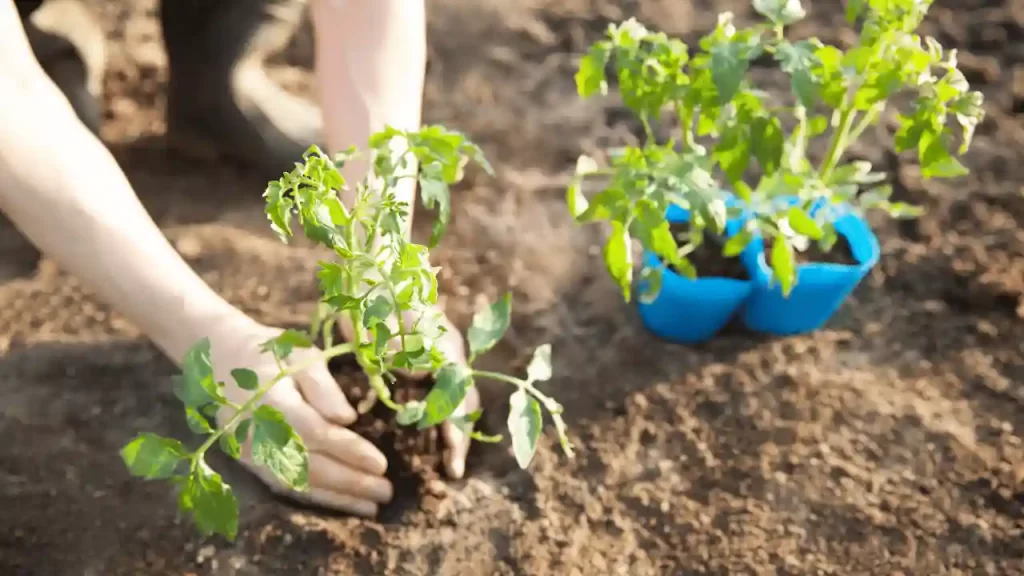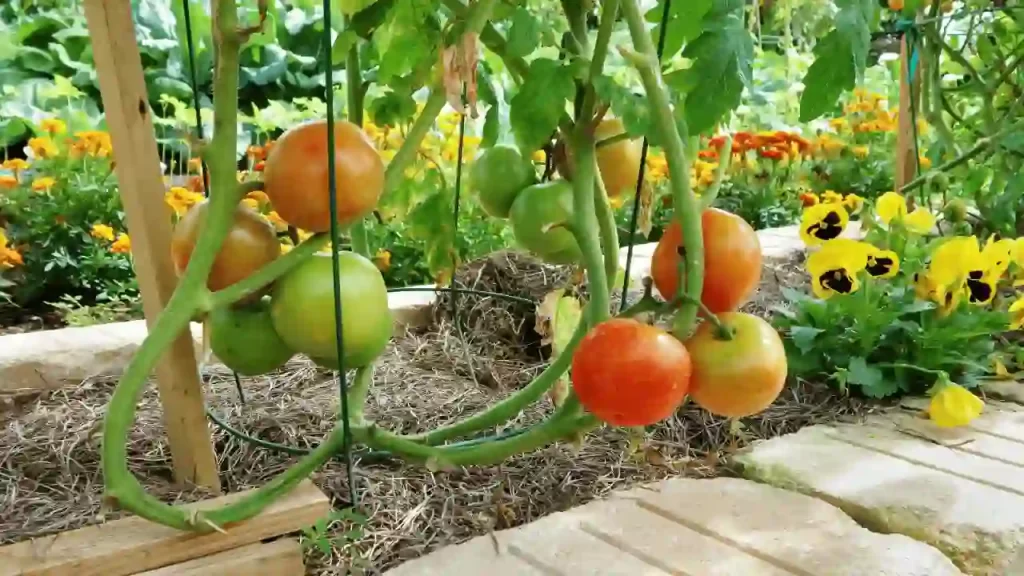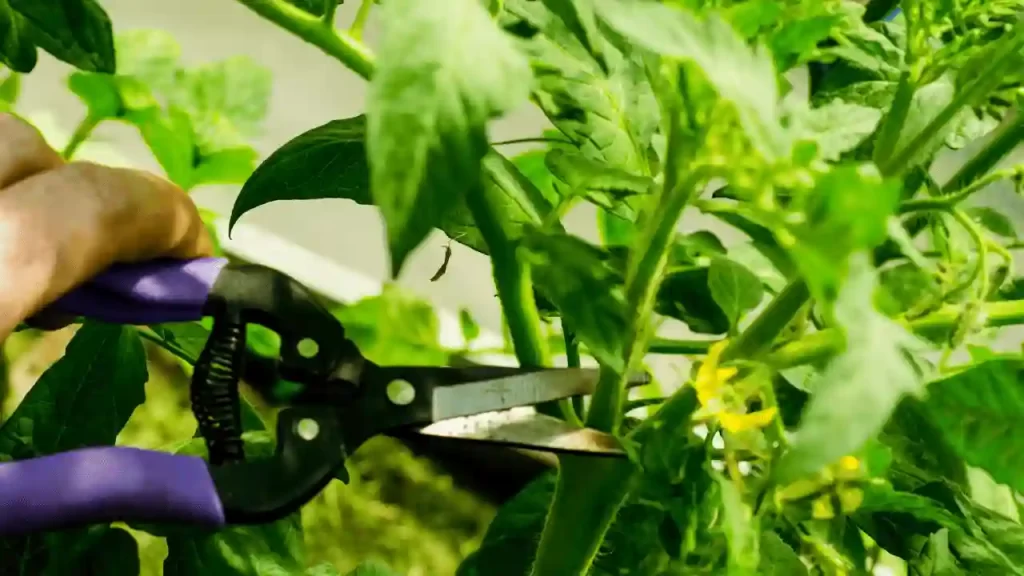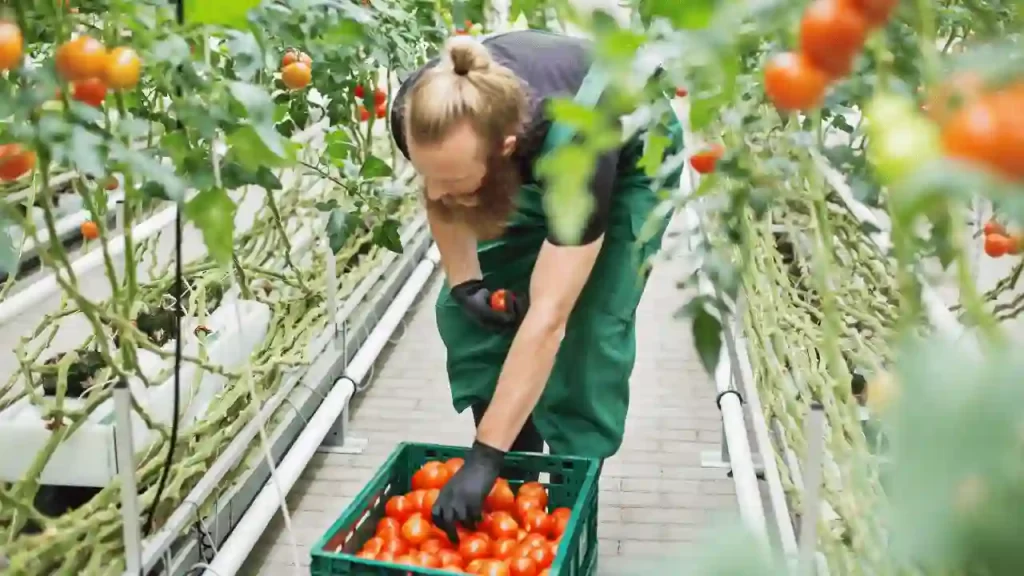Are you planning to grow your tomatoes on your own? Then it is one of the best choices as tomatoes purchased from stores doesn’t seem to be so delicious and full of flavors.
Nature has given us a wide variety of tomatoes with different shapes, sizes, colors, and flavors. You can opt to grow beefsteak tomatoes or cherry tomatoes, according to your choice, and enjoy them.
Short answer: It is easy to grow tomatoes for tomato growers if they keep a few points noted before planting tomatoes:
- Choose a sunny location.
- Deeply dig the soil while transplanting (it enables your plants to develop a strong root system).
- Add fertilizers and water in required amounts and support your plant with the help of stakes or cages.
I have briefly explained the ways of planting and growing tomatoes in this article.
How To Plant Tomatoes?

Choose The Right Spot
Tomato plants love to grow at a place where they can get full exposure to sunlight for at least 6-8 hours per day. If you plan to grow them in a pot, container, or garden bed, try to locate them in an area where they can receive direct sunlight.
But you can initiate the germination process of tomato seeds indoors 4-6 weeks before the end of frost. After the danger of frost has passed, you can bring your plant to the outer environment. You need to be extra cautious about spacing.
For a determinate variety of plants, at least 24 inches of distance is mandatory, whereas 36-48 inches are important for indeterminate plants.
Indeterminate plants continue to grow till frost begins. Rows distance must be at least 36 inches.
Dig Deep
Deep digging of tomato seedlings is quite important to develop a good plant root system.
Remove the lower leaves of the tomato seedlings and place the root balls in the hole so that only the upper leaves of the seedlings remain above the ground.
It helps the plant generate extra roots and prevent them from growing leggy, and the roots become more efficient to uptake water and nutrients.
Add Fertilizer and Water
It’s best to do soil tests and verify if any fertilizers are deficient; if such deficiency is traced, add some general slow-release fertilizer to the planting holes.
After this process, water them properly.
Support Your Tomato Vine Plant
Supporting your tomato plants while the growing stage helps them prevent breakage, maintain good air circulation, and maximize space.
It also prevents the plant’s leaves and fruits from touching the ground, which in turn results in preventing blossom end rot and makes your plant less prone to any diseases.
So you must support your tomato plant, especially the vine variety, just after planting them. You can use a stake, trellis, and cage to support them.
This step is unnecessary while growing a determinate variety of tomato plants as they only grow short.
This is how you should support your young tomato plants:
- Choose 5-6 feet tall tomato cages to support your plant. Place the cage around each tomato plant to prevent uprooting during a storm. Or you can also use stakes to support your tomato plants.
- Use a tall stake to support the plant until it is fully grown.
- Place an 8-foot stake into the ground, and keep 12 inches away from the ground and 4 inches away from the growing plant.
- Use a soft cloth or twine to tie the stake to the twin.
- Ensure that the stems are not damaged at all.
- Regularly check your plant to ensure that ties are not too tight and not cutting the stem of the plants.
How To Successfully Grow Tomatoes?

Most gardeners are well aware of how to grow tomatoes, but growing quality tomatoes with more flavor, tasty and juicy is not a cup of tea.
I have discussed this process step by step to meet the requirement of growing extraordinary tomatoes.
Choose the Right Variety
Nature has blessed us with various tomatoes, enabling us to get tomatoes in different shapes, sizes, and colors. Some choose the variety according to the climatic conditions in their area.
Some of the varieties are more heat or cold-tolerant. You can seek the varieties suitable in your area from a local gardener or USDA National institute of food and Agriculture. Tomatoes are mainly categorized as Determinate and Indeterminate varieties.
Determinate tomatoes variety are also referred to as bush tomatoes. They grow up to 3-4 inches tall and produce fruit only once during a growing season. They are also compact plants and die after making fruit for once. Thus it would be a great choice for container tomatoes.
Indeterminate tomatoes grow till the beginning of the frost. They can produce more delicious tomatoes and produce fruit till they are alive. Beefsteak, big boy, Brandywine, Sungold, and heirlooms only fall into this category.
Planting Tomato Plants
Choose a sunny area and plant your tomato seeds to ¼ inches deep and 1 inch apart in flats.
When your seedlings generate their true leaves, take a plastic cup and insert its stems deeper than before.
This helps your tomato plant to develop a strong root system. Ensure to help your transplants purchased from the nursery develop a strong root system.
Before you bring your tomato transplant into the outer environment and put them in the ground:
- Let the frost completely end, and the temperature becomes stable.
- Find an area in your garden where your plant can get full exposure to sunlight. You should plant tomatoes in well-draining garden soil or potting soil.
- Dig a planting hole in the soil, which should be enough to cover the bottom part of tomato transplants.
- Place the plant in such a manner that only leaves remain above the ground.
- Backfill the soil with compost. This generates maximum roots in the stem, making your tomato plants more productive.
Now water them thoroughly to maintain good moisture in the soil.
Mulch your plant with straw, wood chips, barks, or leaves. It helps to retain moisture in the soil and also suppresses weeds. Keep an eye on pests and diseases, if any, and take necessary actions accordingly.
Place Mulch Around Tomato Plant
Mulching of tomato plants helps retain soil moisture, weed suppression, regulate soil temperature, improve soil quality, and control pests and diseases.
Organic mulch your tomato plants with 3-4 inches-thick layers of leaves, grass clippings, straw, or bark chips can improve the plant’s health and growth.
Water The Plants Regularly
The health and growth of your tomato plant mostly depend on your watering habit. Watering your plant one inch per week makes them healthy.
But always avoid overhead irrigation and direct water in the soil and base of the plant.
You need to water more often during an excessively hot climate to avoid wilting the plant.
Never let the leaves of your tomato plants wet; otherwise, it attracts insects and many other tomato diseases. You can use soaker hoses and drip irrigation to water your tomato plants.
Fertilizing
Fertilizers play a vital role in boosting your tomato plants’ growth and fruit production. After one month of planting, you can apply balanced liquid fertilizers like Nitrogen, potassium, and phosphorus (5:5:5) to your plant.
Then you can apply the 2nd dose of this fertilizer when your plant starts to set flowers and fruits. It encourages the plant to develop more quality fruits.
But always remember not to overuse fertilizers as they can stress your plant.
Stake Tomato Plants
You can use stakes or cages to support your tomato plants. Tie the stem of tomato plants with it. This prevents your plant from touching the ground, and the risk of pests and various diseases is also prevented.
Always ensure to check the ties if they are too tight and cut the stem of the plants.
Take a stake of about 5-7 feet. Dig the soil and insert this stake inside the ground up to 7 inches. You can also make your own cage with welded wires. They are easily available at any hardware store. The square you make should be enough to fit your hands.
Prune Tomato Plants

Pruning is not essential for growing tomato plants, but it encourages plants to use their energy to produce fruits.
Suckers and shoots growing between the main stem and branch suck the energy of the plants.
So you can remove them to let your plant utilize its energy in the right place. Pruning helps to maintain good airflow in the plants.
Harvest Your Tomatoes?

When you harvest your tomatoes at the right time, their flavor and taste are maintained. The tips below can help you properly take care of your harvested tomatoes.
Assess Your Crop
Before harvesting your tomatoes, you should know the right time and stage to harvest them. You can understand this with the texture of tomatoes.
If you find them fully colored and firm, then it is the right time to pluck them. The ideal temperature for ripening tomatoes is 75° Fahrenheit. But any temperature more than 90° Fahrenheit can harm your tomatoes.
As a result, they form a poor color and become extra soft.
If you want to pluck green tomatoes for any reason, you can store them and let them ripen indoors.
Protect Your Picks from Frost
Before the start of the imminent frost, try to harvest all your ripe or semi-ripe tomatoes. Keep them in the temperature range of 50-70 degrees Fahrenheit. Any temperature below 50 degrees Fahrenheit can lead to chilling injury to your tomatoes.
To complete the ripening process, you can put your green tomatoes in closed paper bags. You can also use them to make delicious recipes like tomato pickles or fried green tomatoes.
Examine your plucked tomatoes every week to ensure whether they are ripening. If you spot any rotten tomatoes, pick and dispose of them.
Also, you can take off the whole plant and place them somewhere in a warm location. It helps the fruits to ripen rapidly.
You can also keep your tomatoes near apples and bananas to speed up the ripening process as they generate ethylene gas which helps tomatoes ripen fast.
Store Tomatoes Properly
If tomatoes are stored properly, they can maintain their real taste, flavor, texture, and freshness.
You can store them at room temperature of 50-70 degrees Fahrenheit. Ideally, you can store them at room temperature only for a week.
You can also store them in your fridge, but their taste and flavor are definitely compromised.
Summary
Growing tomatoes might be easy, but growing incredibly tasty, juicy, and flavorful tomatoes requires much effort. If you choose the variety of tomatoes according to your area’s climate, mulch them properly, adopt good watering habits, and fertilize them only when your plants need them. Staking can give you quality and large numbers of tomatoes.
Limited pruning can also enhance the growth of your tomato plants.
If you follow all the steps in this article correctly, nothing can beat you to growing your special tomatoes.
Frequently Asked Questions
What is the best month to plant tomatoes?
The ideal time to plant tomatoes depends on your climate zone and the type of tomato you’re planting.
Generally, tomato plants should be planted outdoors in late spring or early summer when weather conditions are warm and settled.
In cooler climates, April or May may be the best month for planting tomatoes, while in warmer climates, such as the southern U.S., you can plant tomatoes as late as June or July.
Tomatoes are sensitive to cold temperatures, so wait for soil and air temperatures to warm up before planting them.
Should I pinch off tomato flowers?
Yes, it is important to pinch off tomato flowers to ensure that the plant has enough energy to produce a healthy crop of tomatoes.
Pinching off the flowers will prevent them from developing into fruit and redirect the plant’s energy toward growing more foliage and branching out. This will also help increase air circulation around the tomato plant and reduce the chances of disease.
Furthermore, pinching off the flowers will prevent overcrowding in the garden since too many tomatoes can lead to reduced quality and size.
Do tomatoes grow better in pots or in the ground?
Generally, tomatoes grown in pots have a better chance of being sheltered from extreme weather conditions and being easier to manage and water.
However, when planted directly into the ground, tomatoes have more access to nutrients and can grow larger. As a result, the best choice will depend on your growing conditions and preferences.
Planting tomatoes directly into the ground may be preferable if you have ample space in your garden or yard. This will allow them to spread their roots more and take better advantage of nutrients in the soil.
Recent Posts
Are you ready to plant tomatoes for the best tomato harvest of your life? It all starts with getting the fertilizer right! Fertilizing tomatoes can seem daunting, but when done correctly, it’s...
9 Reasons Why Your Tomato Plants Wilting and How To Fix This!
When the gardeners see their lovely and precious tomato plants wilted, they become hopeless, sad, and impatient. But the situation can often be reversed with proper care and adopting a few good...
